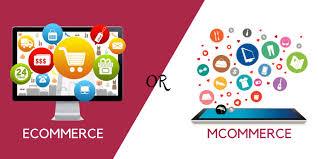E-commerce and m-commerce are both forms of electronic commerce (EC), which is the buying and selling of goods and services over the internet. However, there are some key differences between the two. The main difference between e-commerce and m-commerce is the way in which transactions are conducted.
E-commerce is the buying and selling of goods and services over the internet using a web browser. It is the most widely used form of electronic commerce and is used by businesses and consumers alike. Transactions are usually conducted through a website, with the customer entering their payment details online. This type of e-commerce is often referred to as B2C (Business-to-Consumer) commerce.

M-commerce, on the other hand, refers to the buying and selling of goods or services over mobile devices. It is a relatively new form of EC and is becoming increasingly popular as the use of smartphones and other mobile devices increases. Transactions are usually conducted through a mobile app, with the customer entering their payment details directly into the app. This type of e-commerce is often referred to as B2M (Business-to-Mobile) commerce.
The main difference between e-commerce and m-commerce is the way in which transactions are conducted. With e-commerce, customers are typically required to enter their payment details into a website, while with m-commerce customers can use a mobile app to complete the transaction. This makes m-commerce more convenient and secure than e-commerce, as customers can complete transactions without having to enter their payment information each time.
Another key difference between the two is the level of personalization. E-commerce typically offers a limited level of personalization, as customers are limited to the options available on the website. M-commerce, on the other hand, allows for a higher level of personalization, as customers can customize their experience using the mobile app. This can include customizing product recommendations, setting notifications, and more.
Finally, the cost structure for each type of EC differs. E-commerce is typically cheaper for businesses, as there are no additional costs associated with setting up a website. M-commerce, however, can be more expensive for businesses, as there are usually additional costs associated with developing and maintaining a mobile app.
In conclusion, e-commerce and m-commerce are both forms of EC but there are some key differences between the two. E-commerce is the buying and selling of goods and services over the internet using a web browser, while m-commerce is the buying and selling of goods or services over mobile devices. The main difference between the two is the way in which transactions are conducted, with e-commerce typically requiring customers to enter their payment details into a website, while m-commerce typically allows customers to use a mobile app to complete the transaction. Additionally, e-commerce typically offers a limited level of personalization, while m-commerce allows for a higher level of personalization. Finally, the cost structure for each type of EC differs, with e-commerce typically being cheaper for businesses, while m-commerce can be more expensive for businesses.